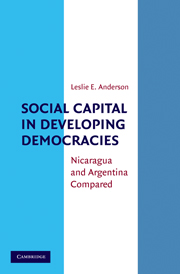Book contents
- Frontmatter
- Contents
- Preface
- 1 An Introduction
- PART I CREATING SOCIAL CAPITAL
- People I Have Known: The Human Face of Popular Politics
- 2 Creating “We”: Sandinismo and Bridging Social Capital
- 3 Creating “Us” and “Them”: Peronism and Bonding Social Capital
- PART II AN EMPIRICAL EXAMINATION OF THE ARGUMENT
- PART III MAKING DEMOCRACY WORK WITHOUT SOCIAL CAPITAL: INSTITUTIONAL CAPITAL
- 8 Conclusion
- Appendix
- Works Cited
- Index
People I Have Known: The Human Face of Popular Politics
Published online by Cambridge University Press: 05 June 2012
- Frontmatter
- Contents
- Preface
- 1 An Introduction
- PART I CREATING SOCIAL CAPITAL
- People I Have Known: The Human Face of Popular Politics
- 2 Creating “We”: Sandinismo and Bridging Social Capital
- 3 Creating “Us” and “Them”: Peronism and Bonding Social Capital
- PART II AN EMPIRICAL EXAMINATION OF THE ARGUMENT
- PART III MAKING DEMOCRACY WORK WITHOUT SOCIAL CAPITAL: INSTITUTIONAL CAPITAL
- 8 Conclusion
- Appendix
- Works Cited
- Index
Summary
Ricardo became a Sandinista. Born in 1944 to a family of modest income in Managua, Nicaragua, Ricardo found himself drawn to religion when he was still a teenager. He began studying in the Catholic high school and decided to become a priest. He worked under the tutelage of then-Bishop Miguel Obando y Bravo. When he was old enough to join the university, Ricardo traveled to Europe, supported by the church, to complete his studies there. He attended a European seminary and met many Catholics from Spain, Belgium, and elsewhere. When he graduated and was ordained a priest, Ricardo returned to Managua to work among the poor. That's where he was on December 23, 1972, when, in the early morning hours, Managua was hit by the most severe earthquake of its history. With extraordinary good luck, Ricardo woke up and rushed out of his room and out into the courtyard of his residence, only to see the walls around him rock and begin to fall. “I saw a woman crushed by a wall,” he told me. “After it fell, all you could see were her legs. It was terrible to see the damage and to see the people suffer. I walked among the ruins, and the people cried for help. All the poor people suffered so much. I always remember that.”
- Type
- Chapter
- Information
- Social Capital in Developing DemocraciesNicaragua and Argentina Compared, pp. 27 - 30Publisher: Cambridge University PressPrint publication year: 2010

